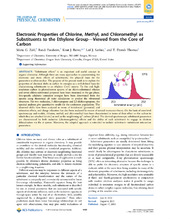| dc.contributor.author | Zahl, Maria Gundersen | |
| dc.contributor.author | Fossheim, Randi | |
| dc.contributor.author | Børve, Knut J. | |
| dc.contributor.author | Sæthre, Leif J | |
| dc.contributor.author | Thomas, T. Darrah | |
| dc.date.accessioned | 2016-01-11T14:07:55Z | |
| dc.date.available | 2016-01-11T14:07:55Z | |
| dc.date.issued | 2015-08-17 | |
| dc.Published | Journal of Physical Chemistry A 2015, 119(36):9481-9493 | eng |
| dc.identifier.issn | 1089-5639 | en_US |
| dc.identifier.uri | https://hdl.handle.net/1956/10925 | |
| dc.description.abstract | “Substituent effects” is an important and useful concept in organic chemistry. Although there are many approaches to parametrizing the electronic and steric effects of substituents, the physical basis for the parameters is often unclear. The purpose of the present work is to explore the properties of chemical shifts in carbon 1s energies as a well-defined basis for characterizing substituents to an ethylene C═C moiety. To this end, high-resolution carbon 1s photoelectron spectra of six chloro-substituted ethenes and seven chloro-substituted propenes have been measured in the gas phase. Site-specific adiabatic ionization energies have been determined from the spectra using theoretical ab initio calculations to predict the vibrational structures. For two molecules, 3-chloropropene and 2,3-dichloropropene, the spectral analyses give quantitative results for the conformer populations. The observed shifts have been analyzed in terms of initial-state (potential) and relaxation effects, and charge relaxation has also been analyzed by means of natural resonance theory. On the basis of core-level spectroscopy and models, chlorine, methyl, and chloromethyl have been characterized in terms of their effect on the carbon to which they are attached (α site) as well as the neighboring sp2 carbon (β site). The derived spectroscopic substituent parameters are characterized by both inductive (electronegativity) effects and the ability of each substituent to engage in electron delocalization via the π system. Moreover, the adopted approach is extended to include substituent–substituent interaction parameters. | en_US |
| dc.language.iso | eng | eng |
| dc.publisher | The American Chemical Society (ACS) Publications | en_US |
| dc.rights | Attribution CC BY | eng |
| dc.rights.uri | http://creativecommons.org/licenses/by/4.0 | eng |
| dc.subject | Ethylene Group | eng |
| dc.title | Electronic properties of chlorine, methyl, and chloromethyl as substituents to the ethylene group-viewed from the core of carbon | en_US |
| dc.type | Peer reviewed | |
| dc.type | Journal article | |
| dc.date.updated | 2015-12-22T10:38:05Z | |
| dc.description.version | publishedVersion | en_US |
| dc.rights.holder | Copyright 2015 American Chemical Society | en_US |
| dc.identifier.doi | https://doi.org/10.1021/acs.jpca.5b05494 | |
| dc.identifier.cristin | 1283186 | |
| dc.subject.nsi | VDP::Matematikk og Naturvitenskap: 400 | en_US |

